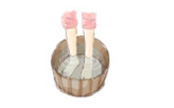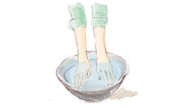Bathing Etiquette
The Radiummelier's Recommendations
- Bathing times and temperatures 5 to 7 minutes in 40-41℃ water
- Take a break for 3 minutes. Bathing is more effective if you also perform some stretches on the legs, back, knees, and wrists.
- Repeat 5 to 7 minutes in 40-41℃ water
Foot baths
- Bathing times and temperatures 10 to 30 minutes in 39-43℃ water
Who is the Radiummelier?
The Radiummelier is a Misasa Onsen professional who is an expert on spring water quality. The word cross between radium and sommelier.
The Radiummelier knows about the history and the spring quality of Misasa Onsen and the effects and the effective use of Onsen.

Bathing process
1 Bathing process
"Rinse your body (kakeyu) first to clean your body and allow it to get used to the temperature of the water.
Start from the feet, which are easily dirtied, then move on to the stomach and shoulders.
Alternatively, rinse your body in the shower."
2 Slowly enter the bath
"Slowly get into the bath, allowing the lower half of your body to get used to the water temperature.
Blood pressure will increase if you jump in the bath suddenly, as your body is still trying to get used to the temperature.
Please be careful when getting into the bath, especially if you have high blood pressure, arterial sclerosis, or diabetes."
3 Wash your body
"Wash your body after it warms up. As your body warms up, your cuticles will become soft and your pores will unclog, allowing you to clean them thoroughly. Wash off your make up before bathing, because the make up will prevent your pores from opening."
4 Bathe for an appropriate time
The right time to get out of the bath is when you start sweating slightly. If start sweating heavily or having palpitations, do not stay in the bath too long.
"Hot bath water over 42 degree strains your body and heart. The appropriate bathing time in hot water is two to three minutes.
We recommend taking a quick hot bath in the morning and having a relaxing bath at night."
5After bathing
Having a shower after your bath will wash off all of the minerals and have a negative effect on the medicinal properties.
If you have dermatitis, however,
it is recommended that you rinse off in the shower.
6After bath
"The amount of body water decreases due to sweating.
Water replacement is important as your blood becomes more concentrated when you sweat.
Please rehydrate with water, tea, or sports drinks.
Also, please take a break of about half an hour to allow your body to recover, because bathing will deplete energy levels and cause blood pressure changes."
Basic bathing techniques
Whole-body bathing

-
"In general, people bathe all the way up to the shoulders.
However, it is difficult to achieve medicinal benefits with this method, as it can put strain on the heart and make people feel sick meaning that it is not possible to stay in the bath for too long.It is necessary to employ some special techniques, such as short-time bathing, taking breaks, and bathing repeatedly."
half-body bathing

-
"The zukansokunetsu method, or ""cold head, hot feet"", can be applied to onsen bathing to reduce the strain on the heart. The proper water depth is up to the stomach. This is an ideal bathing method that doesn’t strain the heart while still allowing the hot spring minerals to penetrate from the lower body.
It stimulates blood circulation, which induces sweating.
Soak in the bath up to your shoulders temporarily, and put a dry towel on your shoulders and rinse your body before you jump in the bath if you feel cold."
Sleeping bath

-
"A bathing method that involves lying immersed up to the neck in shallow water.
An ideal way of bathing that doesn't put too much strain on the heart, while still allowing you to enjoy whole-body bathing.
Be careful not to bathe for too long, though."
Floating bath

-
This type of bathtub is made to allow the bather to achieve a state like floating. Place your head on the edge of the tub, then bend your knees and put your feet on the floor of the tub.
Because the heart is positioned close to the water surface, there is minimal stress from the water pressure. Bathers can comfortably immerse themselves up to the shoulders.
Foot bath

-
This bathing method involves only part of the body in the hot water.
It is possible to gain the benefits of the heat without burdening the body. This method is effective if you cannot bathe due to injury or illness.Bathe the feet in the hot water for three minutes, then immerse them in cold water for a minute (even 20 seconds is OK). Repeat this three to five times. This will improve blood circulation, and help reduce fatigue by discharging lactic acid (which is a cause of fatigue).
Hand bath

-
In general, this involves placing the hands and forearms into a basin. Leaving the hands in for about five minutes at 42℃ is considered effective.
Calories burnt by bathing
- 10 minutes at 40℃ (full body):
- 40kcal
- 10 minutes at 42℃ (full body):
- 80kcal
- 10 minutes slightly fast walking:
- 40kcal
- 10 minutes jogging:
- 80kcal
- Bowl of rice:
- 160kcal


